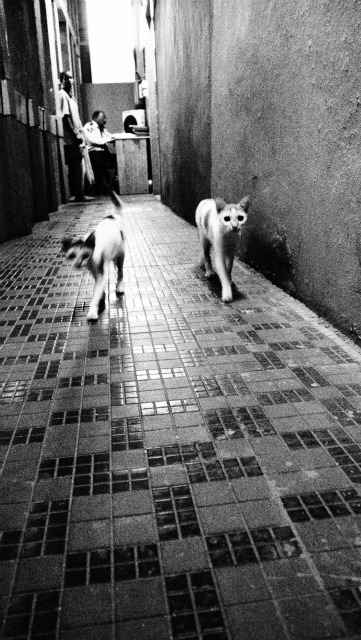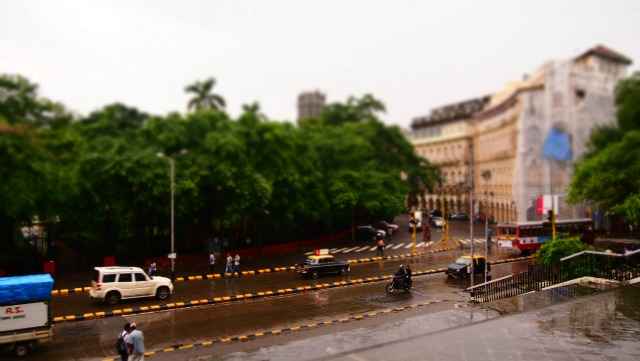Olympus EP3 with the M Zuiko 12mm f/2.0 lens Review
At Rs. 39,900 this is certainly priced higher than most entry level DSLRs but with the kind of features provided, options to add on accessories and the image quality, we feel it makes for a great buy for someone looking at DSLR-like quality in a compact form factor. For street photography, we have yet to come across a more feature-rich mirrorless compact.
This model has the same 12.3MP Live MOS sensor found on its predecessor, the E-P2. The E-P3 houses a new TruePic VI image processor which is dual core. That effectively means that you can continue using the Live view mode while the image is being processed. It also works wonders when you are using the Creative Art filters and applying them to a single image, as we will see later. It also checks the focus about 120 times a second which brings us to one of its top features. That of having a extremely fast auto-focus.
Build and Design
The Olympus EP3 has an all-metal body with three types of hand grips to choose from. An addition over the previous generation EP2 is the presence of a flash unit onboard. The flash unit is assembled as a pop-up type unit, so that it merges with the top portion of the camera. The jog dial is located on the right hand side of the hot-shoe section. Shutter is located just beside the jog dial.
On the rear side you have the 610k dot OLED screen which has a capacitive touch response. You can select the focus points from over 35 AF points by touch as well. Not just that, you can also fire the shutter by tapping on the touchscreen.
Button layout around the screen is quite intuitive and all of them are located on the right hand side. There is a record button for video recording followed by magnifier button which comes handy while manual focussing. Fn1 and Fn2 buttons can be programmed with specific tasks such as exposure lock among others.
A Zuiko Digital ED 14-42mm R (f/3.5 – f/5.6) kit lens is bundled with the EP3. It has a metallic manual focus rim which complements the metal body of the EP3.
Features
The user interface of the EP3 has improved from the previous generation and is quite easy to navigate through. Though it can get a bit too exhaustive for a beginner as there are many sub-menus within each menu. Also the menus change according to the mode of shooting selected.
Creative Art filters go beyond your traditional sepia mode, vivid mode, etc. You have some fascinating filters such as Grainy film (noisy BW filter), Dramatic Tone (adding mood to the sky), Diorama (simulates tilt-shift lens photography), among others. Each of these Art filters has options to further add tweaks.
There are as many as 23 SCN modes with options to even select individual eyes in a portrait shot or even take a 3D shot. It can shoot in both RAW as well as JPEG. The video recording can shoot upto 1080i at 60fps in AVCHD format.
Performance
We shot using the kit lens – 14-42mm (f3.5 – f5.6). Image quality is quite good with crisp colours and high level of detailing. While shooting outdoors the finer details start deteriorating only after ISO 1600. We did notice a slight amount of colour cast around the sharper edges while shooting in the macro mode. Indoor shots started showing noise even on lower ISOs.
[RELATED_ARTICLE]Single shot auto focus is blazing fast and is one of the major plus points for street photography enthusiasts as it is pertinent to get the decisive moment right. You can also activate the touch-focus-shoot function, whereby you can select the point you want to focus on and take a shot by just touching that point. Although the response was quick, we noticed a slight loss in accuracy of the focus on the desired spot. It is best to use the shutter to click photographs and there are enough focussing points to choose from.
Movie mode supports continuous AF and we did not notice any jerks even on the highest resolution which is quite common on most compact cameras, specially whilst panning.
|
Grainy Creative ART filter output
|
Diorama mode of the Creative ART filter
|
Dramatic Tone mode of Creative ART filter
|
Creative Art Filters are a great accessory for amateurs who want on-the-spot editing. But we noticed that the Grainy filter tends to blow out the highlights by quite a bit. The Dramatic mode looks great only if you have a cloudy sky, otherwise if you try using it on a flat sky, you will get black blotches which does not really add to the appeal of the photograph.
Art Filter bracketing is a lovely way to apply many filters to one image at a time. Obviously, it will take some time to apply the filters, but at the end you will get multiple filters applied to the same image rather than having to select each filter individually.
Rating
Features: 8
Performance: 7
Build Quality: 6.5
Value for money: 6.5
Overall: 7
Price Olympus EP3: Rs. 39,999
Verdict
At Rs. 39,900 this is certainly priced higher than most entry level DSLRs but with the kind of features provided, options to add on accessories and the image quality, we feel it makes for a great buy for someone looking at DSLR-like quality in a compact form factor. For street photography, we have yet to come across a more feature-rich mirrorless compact.
Contact
Olympus Imaging India Pvt. Ltd
Phone: 91 22 6142 0400
Email: inquiry@olympus.in
Website: www.olympus-imaging.co.in
Read our review of the Olympus M Zuiko 12mm f2.0 lens, on Page 2…
Olympus M Zuiko 12mm f2.0 lens
Alongwith the EP3, Olympus has also introduced a range of new lenses. We got our hands on the 12mm prime lens – the M Zuiko Digital ED 12mm f/2.0 lens (24mm equivalent on the 35mm cameras). Out of the box, this lens looks quite impressive with its all-metal body. This also complements the metal body of the Olympus EP3 body quite well.
[RELATED_ARTICLE]For a 12mm prime lens, it’s not got a very slim profile, specially when you compare it with the older Olympus 17mm f/2.8 lens. The reason for that is quite evident in the build itself. The M Zuiko 12mm lens incorporates a Snapshot-focus ring on the lens. A metal ring can be shifted back (towards the camera body) for manually focussing on objects and there is a distance marking. It comes with the MSC (Movie and Still Compatible) option which results in fast and noiseless auto focussing for both still images as well as movies. The lens comprises 11 elements housed in 8 groups such as a Dual Super Aspherical element, a Super High Refractive index element and an Extra-low Dispersion element. The surface of the lens is coated with Zuiko Extra-low Reflection Optical (ZERO) coating which helps in avoiding lens flare.
Image quality is top-notch and the fast auto-focus mechanism makes it ideal for street shooting. Snapshot focussing is a joy to work on specially on the streets when you have prefocussed shots based on the distance. We did not notice any lens flares inspite of pointing the camera a brightly lit scenes. Chromatic aberration was not noticeable at all.
For example in the image of the horse below, notice the sharpness in the strands of hair at 100 percent crop. Also you will not notice any chromatic aberrations around the fur on the ears.
|
Full shot of the horse
|
Each strand of the horse’s hair is visible
|
In this shot the strong columns of the Rajabai Tower are quite distinct from the blown out sky and there is no purple fringing on the edges at 100 percent crop.
|
Full shot of Rajabai Tower
|
Notice the absence of any aberrations despite the sky being blown out
|
The shallow depth of field results in a smooth out of focus backgrounds.
Also while shooting at night at ISO 1000 with f/2.0 one notices minor noise in the image. Also note that there is no fringing on the edge of the metal plate in the bottom left hand.
|
At its widest aperture, you get a very soft shallow depth of field
|
Even at ISO 1000, you will notice minimal noise. Also there is no fringing at the edge of the metal plate
|
Rating
Features: 8
Performance: 8.5
Build Quality: 9
Value for money: 6.5
Overall: 8
Price
Olympus M Zuiko 12mm f/2.0 lens: Rs. 44,995
Verdict
For the M Zuiko 12mm f/2.0 lens the price tag of Rs. 44,995 is more than the cost of an EP3. But then, wide angle prime lenses are costly. Quality wise, it is a brilliant lens and one will find very little to complain about. The lens is great for street photography, low-light condition shooting and landscape photography.
Contact
Olympus Imaging India Pvt. Ltd
Phone: 91 22 6142 0400
Email: inquiry@olympus.in
Website: www.olympus-imaging.co.in














